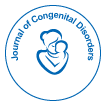Our Group organises 3000+ Global Conferenceseries Events every year across USA, Europe & Asia with support from 1000 more scientific Societies and Publishes 700+ Open Access Journals which contains over 50000 eminent personalities, reputed scientists as editorial board members.
Open Access Journals gaining more Readers and Citations
700 Journals and 15,000,000 Readers Each Journal is getting 25,000+ Readers
Useful Links
Recommended Journals
Share This Page
Congenital Heart
Congenital Heart Disease (CHD) is the most common congenital disorder in new-borns. Approximately 1 in every 100 new-borns have congenital heart defects, which can range from mild too severe. Critical CHD requires surgery or catheter-based intervention in the first year of life, this occurs in approximately 25 percent. Although many new-borns with critical CHD are symptomatic and identified soon after birth, others are not diagnosed until after discharge from the birth hospitalization.In infants with critical cardiac lesions, the risk of morbidity and mortality increases when there is a delay in diagnosis and timely referral to a tertiary centre with expertise in treating these patients. Some are known to be associated with genetic disorders, such as Down syndrome, but the cause of most congenital heart defects is unknown. While they can't be prevented, there are many treatments for the disease and related health problems.
Congenital Heart
Expert PPTs
- Kazuo Nakamura
The relationship between vitamin K content in the body and insufficient coagulation control
PPT Version | PDF Version - Hosam A Elbaz
Characterization of the pharmacological effects of cardiac glycosides on lung epithelial cells
PPT Version | PDF Version
Speaker PPTs
- Donald silverberg
Is correction of iron deficiency a new addition to the treatment of heart failure?
PPT Version | PDF Version - Ahmed Zeidan
Effects of intravenous iron in chronic kidney disease and heart failure
PPT Version | PDF Version - Yosef Yarden
Classically, the 3ââ¬â¢untranslated region (3ââ¬â¢UTR) is that region in eukaryotic protein-coding genes from the translation termination codon to the polyA signal. It is transcribed as an integral part of the mRNA encoded by the gene. However, there exists another kind of RNA, which consists of the 3ââ¬â¢UTR alone, without all other elements in mRNA such as 5ââ¬â¢UTR and coding region. The importance of independent 3ââ¬â¢UTR RNA (referred as I3ââ¬â¢UTR) was prompted by results of artificially introducing such RNA species into malignant mammalian cells. Since 1991, we found that the middle part of the 3ââ¬â¢UTR of the human nuclear factor for interleukin-6 (NF-IL6) or C/EBP gene exerted tumor suppression effect in vivo. Our subsequent studies showed that transfection of C/EBP 3ââ¬â¢UTR led to down-regulation of several genes favorable for malignancy and to up-regulation of some genes favorable for phenotypic reversion. Also, it was shown that the sequences near the termini of the C/EBP 3ââ¬â¢UTR were important for its tumor suppression activity. Then, the C/EBP 3ââ¬â¢UTR was found to directly inhibit the phosphorylation activity of protein kinase CPKC in SMMC-7721, a hepatocarcinoma cell line. Recently, an AU-rich region in the C/EBP 3ââ¬â¢UTR was found also to be responsible for its tumor suppression. Recently we have also found evidence that the independent C/EBP 3ââ¬â¢UTR RNA is actually exists in human tissues, such as fetal liver and heart, pregnant uterus, senescent fibroblasts etc. Through 1990ââ¬â¢s to 2000ââ¬â¢s, world scientists found several 3ââ¬â¢UTR RNAs that functioned as artificial independent RNAs in cancer cells and resulted in tumor suppression. Interestingly, majority of genes for these RNAs have promoter-like structures in their 3ââ¬â¢UTR regions, although the existence of their transcribed products as independent 3ââ¬â¢UTR RNAs is still to be confirmed. Our studies indicate that the independent 3ââ¬â¢UTR RNA is a novel non-coding RNA species whose function should be the regulation not of the expression of their original mRNA, but of some essential life activities of the cell as a whole.
PPT Version | PDF Version - Wioletta Wujcicka
Genetic modifications within TLR4 and TLR9 genes contribute into congenital toxoplasmosis and cytomegaly development
PPT Version | PDF Version - Ishfaq A Bukhari
Protective Effect of Diltiazem and Fenofibrate Against Ischemia-reperfusion Induced Cardiac Arrhythmias in the Isolated Rat Heart.
PPT Version | PDF Version - A Martin Gerdes
Wrong about ò-blockers! Wrong about positive inotropes! Wrong about Thyroid Hormone treatment of Heart Failure?
| PDF Version - Fatih Yalcin
EARLY IMAGING BIOMARKER IN REMODELING DUE TO HEART FAILURE
| PDF Version - Samuel C Dudley
Novel biomarkers for diastolic heart failure
| PDF Version - Abdulaziz U Joury
Acute Myocardial Infarction as First Presentation among patients with Coronary Heart Disease
PPT Version | PDF Version - Helena Dominguez
Can we protect the brain against thromboembolism during open heart surgery? LAACS project
| PDF Version - Saverio Gentile
Ion channels phosphorylopathy: 3rd International Conference on Clinical & Experimental Cardiology April 15-17, 2013 A link between genomic variations and heart arrhythmia
| PDF Version
